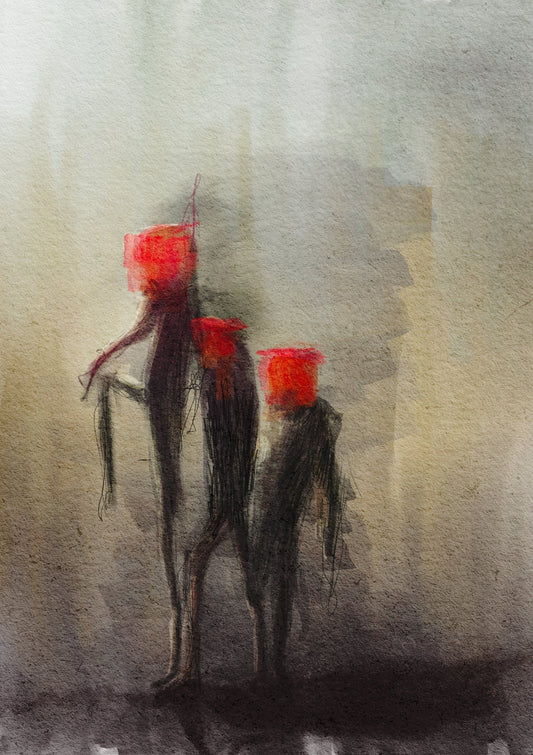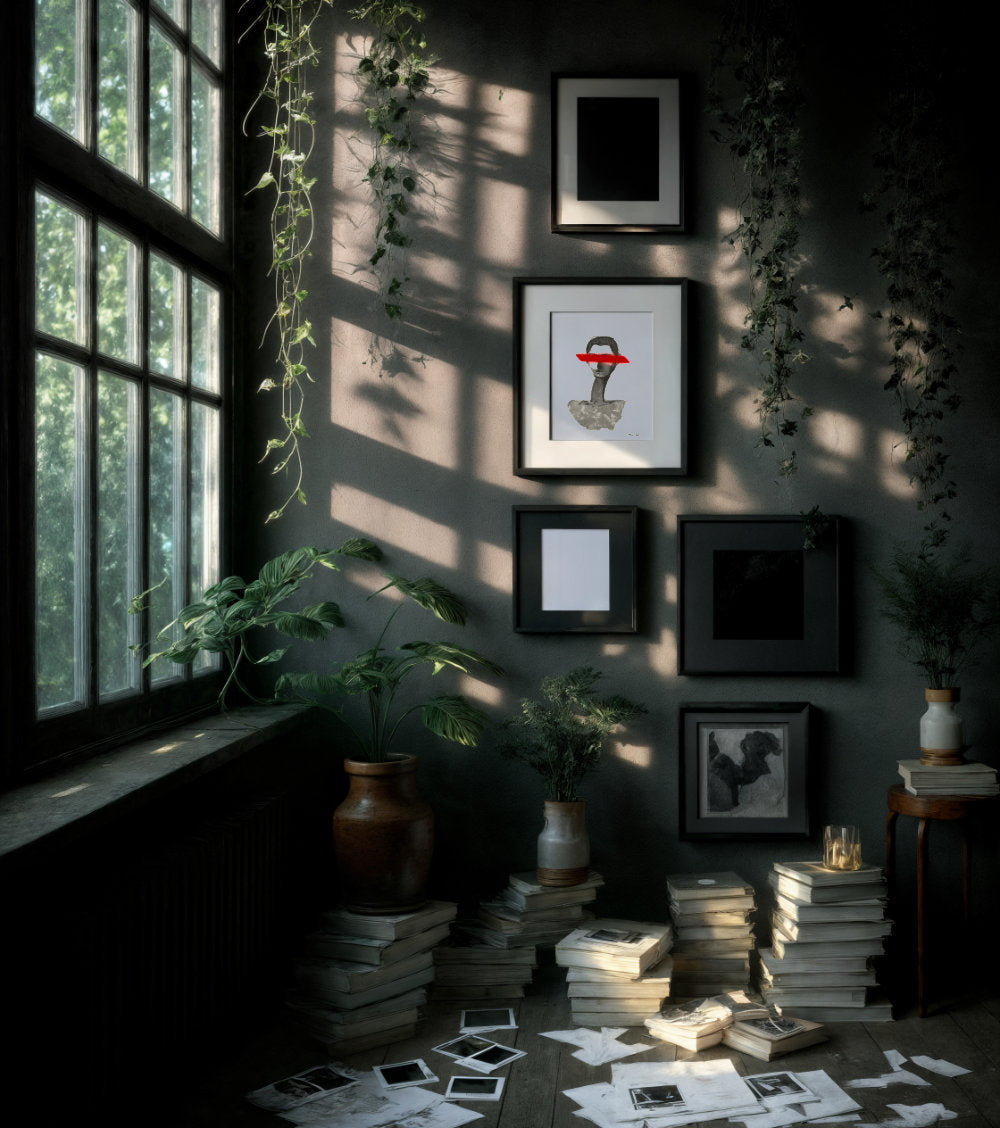
Dark Wall Art: The Beauty in Melancholic Expression
Understanding Melancholy and Its Artistic Expression

Melancholy represents a complex emotional state that is distinct from clinical depression. While depression often involves persistent hopelessness, melancholy combines contemplative sadness with the potential for insight and creativity . The term originates from ancient Greek medical theory, where it described a reflective state of mind that could enhance creative thinking. Gothic and alternative art movements have long embraced these themes, creating spaces where authentic emotional expression flourishes.
Today, melancholy often involves:
- A bittersweet emotional awareness
- Deep reflection and introspection
- Creative contemplation
- Meaningful sadness that can lead to personal growth
Important note: If you experience persistent sadness, loss of interest, or hopelessness, please seek professional help . While melancholic art can support emotional well-being, it does not replace mental health treatment.
The Healing Power of Melancholic Art

Research suggests that melancholic art can help support emotional healing. Studies indicate that engaging with emotional artwork may improve mental well-being in various ways. This healing potential exists for both artists and viewers.
Creating Art for Emotional Release
Studies indicate that creating emotional artwork can help reduce anxiety and depression symptoms (Hu et al., 2021). The creative process offers a safe space for expressing and processing complex feelings.
Research highlights several potential benefits:
- Art-making may reduce stress levels
- Creative expression can help process difficult experiences
- Regular art practice often supports emotional regulation
- Visual storytelling can build self-understanding
Simple ways to start creating:
- Daily sketching or doodling
- Photography that captures mood
- Expressive journaling with drawings
- Color-based emotion mapping
Finding Light in Darkness

Melancholic art often combines elements of sadness with glimpses of hope. Research suggests this balance helps viewers feel understood while maintaining optimism. Studies indicate that art incorporating both emotional depth and uplifting elements may provide enhanced therapeutic benefits (Kozhyna et al., 2017).
This dual nature can:
- Help viewers feel less isolated
- Demonstrate the temporary nature of difficult emotions
- Support emotional resilience
- Foster human connection
The Gothic Embrace of Melancholic Dark Wall Art

Gothic culture has long celebrated the beauty within darkness, making it a natural home for melancholic art. The gothic aesthetic embraces emotional depth and finds profound meaning in exploring life's darker aspects. This cultural appreciation creates safe spaces for processing complex feelings through art.
Key connections include:
- Gothic art's focus on emotional authenticity
- Celebration of beauty within darkness
- Deep appreciation for symbolic expression
- Welcoming of diverse emotional experiences
The gothic community often resonates with melancholic art because:
- It validates complex emotional states
- Embraces the transformative power of darkness
- Creates spaces for authentic self-expression
- Values depth over superficial positivity
This cultural connection provides:
- Supportive communities for artists and viewers
- Rich symbolic language for emotional expression
- Historical context for processing difficult feelings
- Appreciation for the full spectrum of human experience
Understanding Art's Impact

Research indicates that viewing emotional art may positively affect mental health. Studies have observed that people who engage with such artwork may often experience:
- Enhanced mood awareness
- Increased emotional understanding
- Better stress management
- Improved coping strategies
Scientists have also noted that engaging with emotional art can activate brain regions associated with emotional processing (Chiang et al., 2019). This suggests that visual experiences may help people understand and work through their feelings.
Building Community Through Shared Experience
Melancholic art can create meaningful connections between artists and viewers. Personal accounts from the art community demonstrate how shared emotional experiences often reduce feelings of isolation. Artists who express their struggles through visual media frequently help others feel understood.
These connections may develop because:
- Viewers recognize shared experiences
- Visual storytelling transcends language barriers
- Art provides safe spaces for emotional exploration
- Creative expression invites empathy
Practical Ways to Engage with Melancholic Art
Start your journey by:
- Visiting local art galleries
- Joining online art communities
- Creating a collection of artworks that moves you
- Participating in art therapy workshops
- Following artists whose work resonates with you, like my melancholic art prints collection.
Remember to:
- Set emotional boundaries
- Take breaks when needed
- Share your experiences with trusted friends
- Seek support if art triggers difficult emotions
Hope Lives in Dark Places

Contemporary dark melancholic wall art often weaves together darkness and light. Research suggests this combination helps viewers process difficult emotions while maintaining hope. Studies indicate that art balancing sadness with beauty may create a particularly meaningful impact (Kozhyna et al., 2017).
This approach works by:
- Validating complex feelings
- Finding beauty in authentic expression
- Providing emotional release
- Creating space for healing
Conclusion
Melancholic art or Dark wall art offers unique opportunities for emotional processing and healing. Research suggests it can have positive effects on mental well-being, while personal experiences demonstrate its power to create connection. The thoughtful combination of darkness and hope in emotional artwork provides pathways for understanding, processing, and growing through difficult feelings.
My favourite quote from Artist Mariko Mori :
"We have a language barrier and cultural differences that can hinder communication, but art transcends these barriers and speaks directly to the soul."
References
- Hu, J., et al. (2021). Art Therapy: A Complementary Treatment for Mental Disorders. Frontiers in Psychology, 12.
- Chiang, M., et al. (2019). Creative art therapy for mental illness. Psychiatry Research, 275, 129-136.
- Kozhyna, H., et al. (2017). The Use of Art Therapy in Complex Treatment on the Quality of Remission in Patients with Melancholy in Major Depressive Disorder. European Psychiatry, 41.


